BMW 325xi TOURING 2002 E46 Service Manual
Manufacturer: BMW, Model Year: 2002, Model line: 325xi TOURING, Model: BMW 325xi TOURING 2002 E46Pages: 155, PDF Size: 2.17 MB
Page 41 of 155
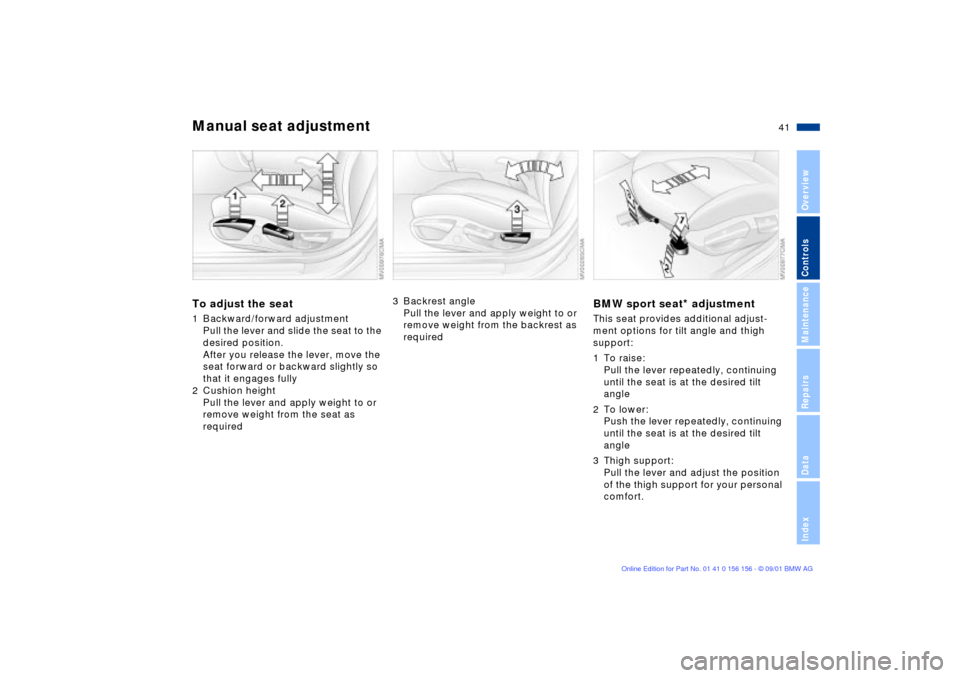
41n
OverviewControlsMaintenanceRepairsDataIndex
Manual seat adjustmentTo adjust the seat1 Backward/forward adjustment
Pull the lever and slide the seat to the
desired position.
After you release the lever, move the
seat forward or backward slightly so
that it engages fully
2 Cushion height
Pull the lever and apply weight to or
remove weight from the seat as
required
3 Backrest angle
Pull the lever and apply weight to or
remove weight from the backrest as
required
BMW sport seat
* adjustment
This seat provides additional adjust-
ment options for tilt angle and thigh
support:
1 To raise:
Pull the lever repeatedly, continuing
until the seat is at the desired tilt
angle
2 To lower:
Push the lever repeatedly, continuing
until the seat is at the desired tilt
angle
3 Thigh support:
Pull the lever and adjust the position
of the thigh support for your personal
comfort.
Page 42 of 155
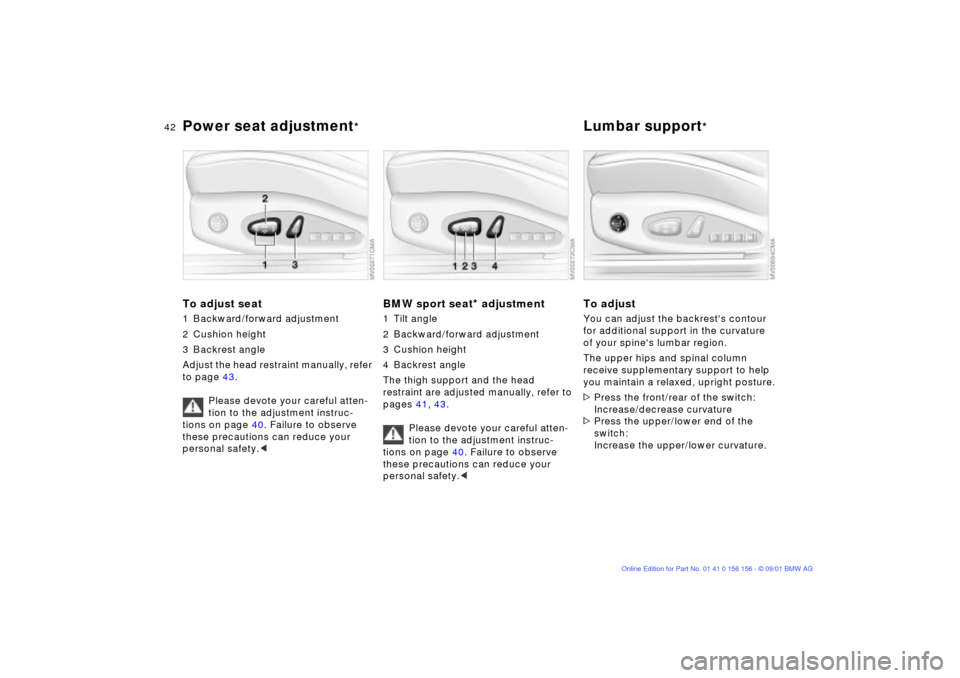
42n
Power seat adjustment
*
Lumbar support
*
To adjust seat1 Backward/forward adjustment
2 Cushion height
3 Backrest angle
Adjust the head restraint manually, refer
to page 43.
Please devote your careful atten-
tion to the adjustment instruc-
tions on page 40. Failure to observe
these precautions can reduce your
personal safety.<
BMW sport seat
* adjustment
1 Tilt angle
2 Backward/forward adjustment
3 Cushion height
4 Backrest angle
The thigh support and the head
restraint are adjusted manually, refer to
pages 41, 43.
Please devote your careful atten-
tion to the adjustment instruc-
tions on page 40. Failure to observe
these precautions can reduce your
personal safety.<
To adjustYou can adjust the backrest's contour
for additional support in the curvature
of your spine's lumbar region.
The upper hips and spinal column
receive supplementary support to help
you maintain a relaxed, upright posture.
>Press the front/rear of the switch:
Increase/decrease curvature
>Press the upper/lower end of the
switch:
Increase the upper/lower curvature.
Page 43 of 155
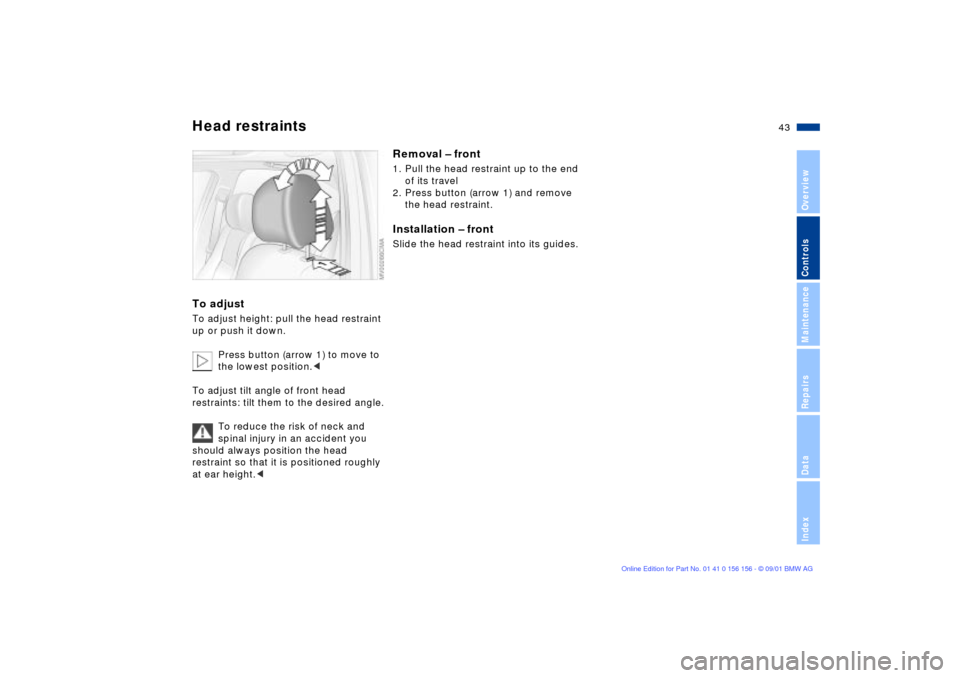
43n
OverviewControlsMaintenanceRepairsDataIndex
Head restraints To adjust To adjust height: pull the head restraint
up or push it down.
Press button (arrow 1) to move to
the lowest position.<
To adjust tilt angle of front head
restraints: tilt them to the desired angle.
To reduce the risk of neck and
spinal injury in an accident you
should always position the head
restraint so that it is positioned roughly
at ear height.<
Removal Ð front1. Pull the head restraint up to the end
of its travel
2. Press button (arrow 1) and remove
the head restraint.Installation Ð frontSlide the head restraint into its guides.
Page 44 of 155
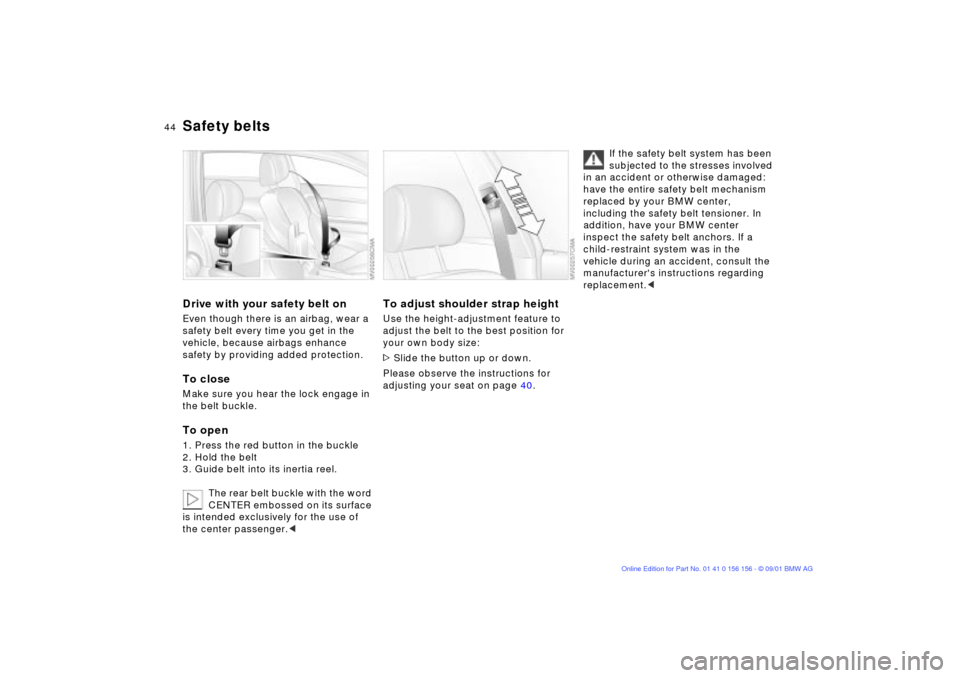
44n
Safety beltsDrive with your safety belt onEven though there is an airbag, wear a
safety belt every time you get in the
vehicle, because airbags enhance
safety by providing added protection.To closeMake sure you hear the lock engage in
the belt buckle.To open1. Press the red button in the buckle
2. Hold the belt
3. Guide belt into its inertia reel.
The rear belt buckle with the word
CENTER embossed on its surface
is intended exclusively for the use of
the center passenger.<
To adjust shoulder strap heightUse the height-adjustment feature to
adjust the belt to the best position for
your own body size:
>Slide the button up or down.
Please observe the instructions for
adjusting your seat on page 40.
If the safety belt system has been
subjected to the stresses involved
in an accident or otherwise damaged:
have the entire safety belt mechanism
replaced by your BMW center,
including the safety belt tensioner. In
addition, have your BMW center
inspect the safety belt anchors. If a
child-restraint system was in the
vehicle during an accident, consult the
manufacturer's instructions regarding
replacement.<
Page 45 of 155
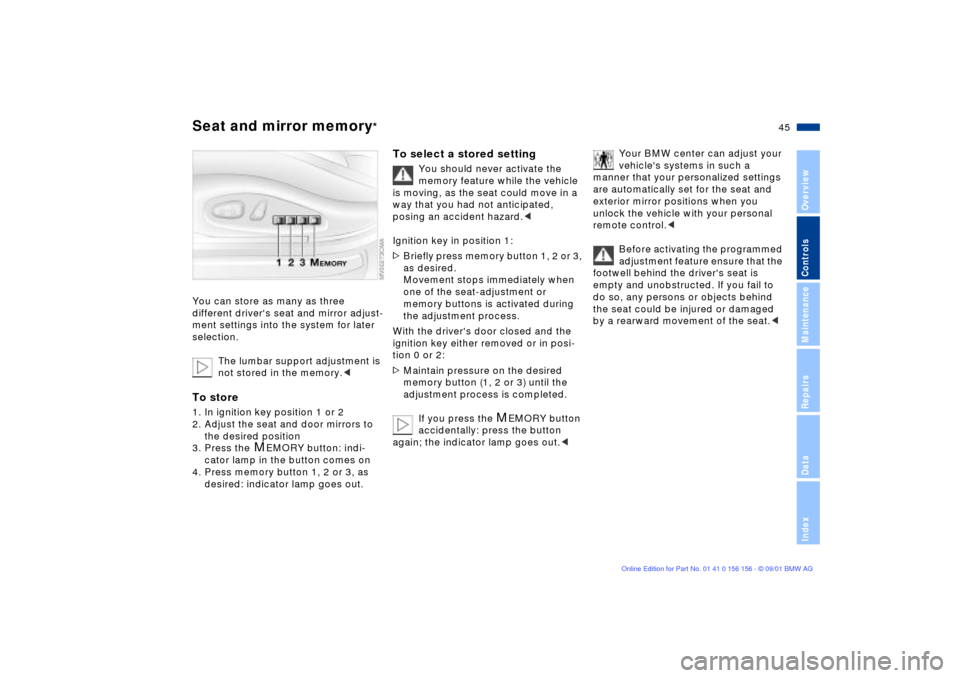
45n
OverviewControlsMaintenanceRepairsDataIndex
Seat and mirror memory
*
You can store as many as three
different driver's seat and mirror adjust-
ment settings into the system for later
selection.
The lumbar support adjustment is
not stored in the memory.
the desired position
3. Press the
M
EMORY button: indi-
cator lamp in the button comes on
4. Press memory button 1, 2 or 3, as
desired: indicator lamp goes out.
To select a stored setting
You should never activate the
memory feature while the vehicle
is moving, as the seat could move in a
way that you had not anticipated,
posing an accident hazard.<
Ignition key in position 1:
>Briefly press memory button 1, 2 or 3,
as desired.
Movement stops immediately when
one of the seat-adjustment or
memory buttons is activated during
the adjustment process.
With the driver's door closed and the
ignition key either removed or in posi-
tion 0 or 2:
>Maintain pressure on the desired
memory button (1, 2 or 3) until the
adjustment process is completed.
If you press the
M
EMORY button
accidentally: press the button
again; the indicator lamp goes out.<
Your BMW center can adjust your
vehicle's systems in such a
manner that your personalized settings
are automatically set for the seat and
exterior mirror positions when you
unlock the vehicle with your personal
remote control.<
Before activating the programmed
adjustment feature ensure that the
footwell behind the driver's seat is
empty and unobstructed. If you fail to
do so, any persons or objects behind
the seat could be injured or damaged
by a rearward movement of the seat.<
Page 46 of 155
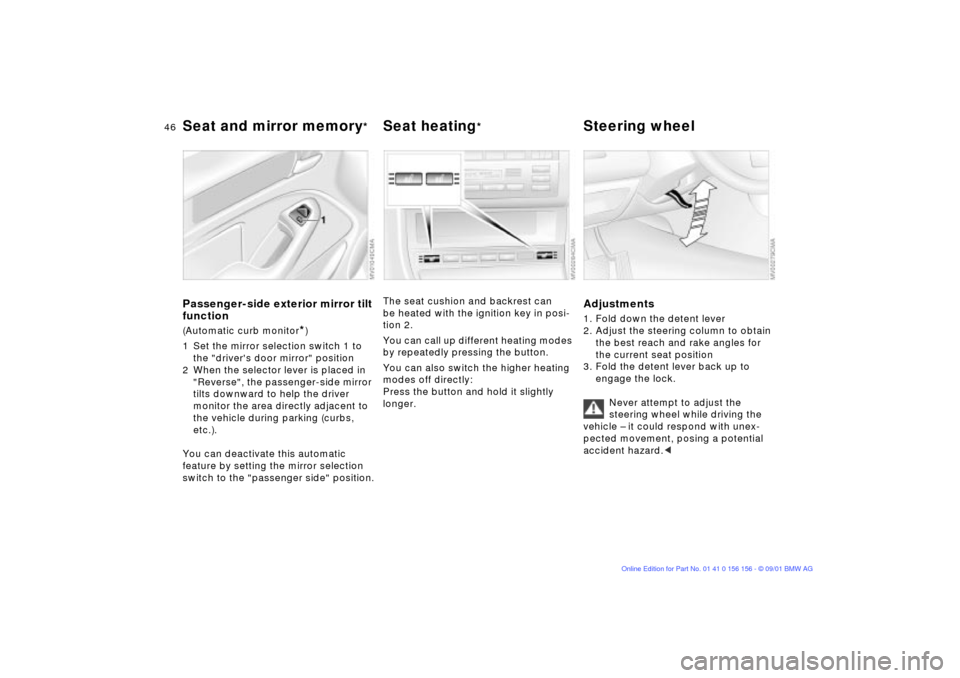
46n
Seat and mirror memory
*
Seat heating
*
Steering wheel
Passenger-side exterior mirror tilt
function(Automatic curb monitor
*)
1 Set the mirror selection switch 1 to
the "driver's door mirror" position
2 When the selector lever is placed in
"Reverse", the passenger-side mirror
tilts downward to help the driver
monitor the area directly adjacent to
the vehicle during parking (curbs,
etc.).
You can deactivate this automatic
feature by setting the mirror selection
switch to the "passenger side" position.
The seat cushion and backrest can
be heated with the ignition key in posi-
tion 2.
You can call up different heating modes
by repeatedly pressing the button.
You can also switch the higher heating
modes off directly:
Press the button and hold it slightly
longer.
Adjustments1. Fold down the detent lever
2. Adjust the steering column to obtain
the best reach and rake angles for
the current seat position
3. Fold the detent lever back up to
engage the lock.
Never attempt to adjust the
steering wheel while driving the
vehicle Ð it could respond with unex-
pected movement, posing a potential
accident hazard.<
Page 47 of 155
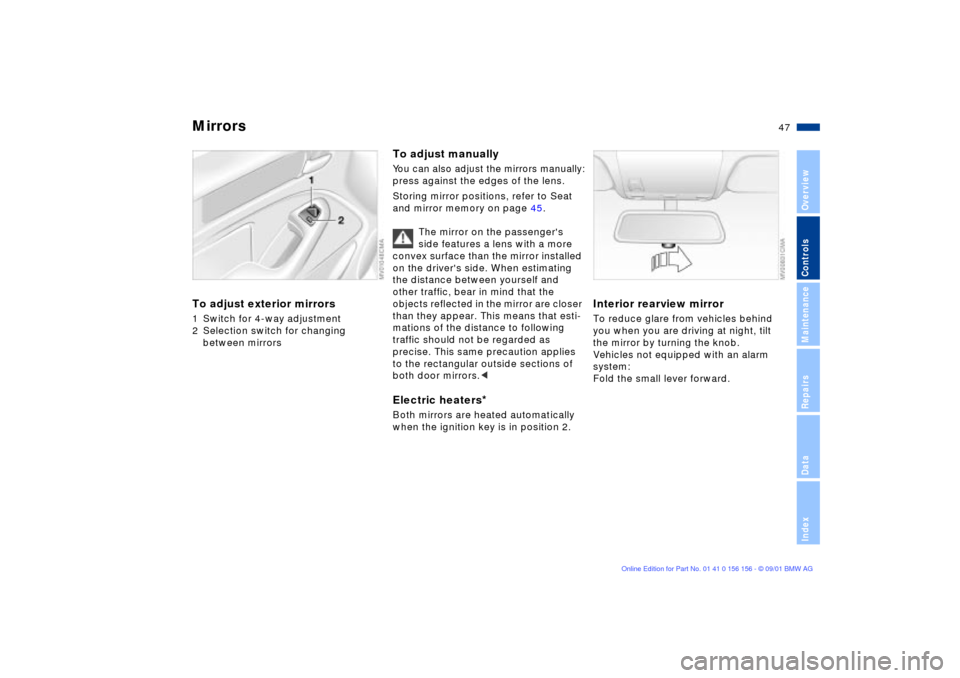
47n
OverviewControlsMaintenanceRepairsDataIndex
Mirrors To adjust exterior mirrors1 Switch for 4-way adjustment
2 Selection switch for changing
between mirrors
To adjust manuallyYou can also adjust the mirrors manually:press against the edges of the lens.
Storing mirror positions, refer to Seat
and mirror memory on page 45.
The mirror on the passenger's
side features a lens with a more
convex surface than the mirror installed
on the driver's side. When estimating
the distance between yourself and
other traffic, bear in mind that the
objects reflected in the mirror are closer
than they appear. This means that esti-
mations of the distance to following
traffic should not be regarded as
precise. This same precaution applies
to the rectangular outside sections of
both door mirrors.
Both mirrors are heated automatically
when the ignition key is in position 2.
Interior rearview mirror To reduce glare from vehicles behind
you when you are driving at night, tilt
the mirror by turning the knob.
Vehicles not equipped with an alarm
system:
Fold the small lever forward.
Page 48 of 155
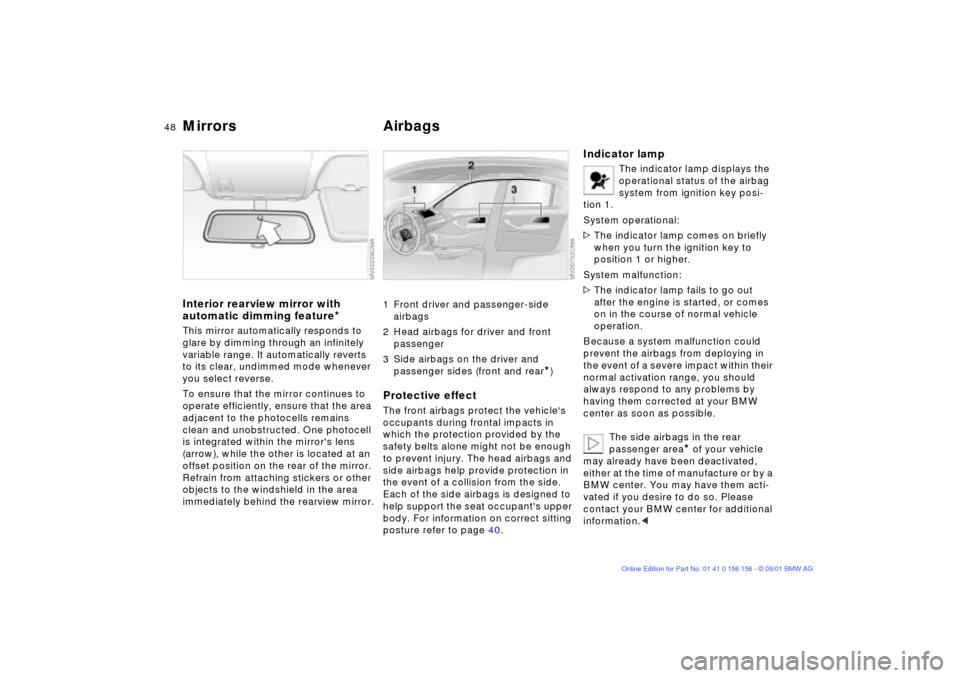
48n
Mirrors AirbagsInterior rearview mirror with
automatic dimming feature
*
This mirror automatically responds to
glare by dimming through an infinitely
variable range. It automatically reverts
to its clear, undimmed mode whenever
you select reverse.
To ensure that the mirror continues to
operate efficiently, ensure that the area
adjacent to the photocells remains
clean and unobstructed. One photocell
is integrated within the mirror's lens
(arrow), while the other is located at an
offset position on the rear of the mirror.
Refrain from attaching stickers or other
objects to the windshield in the area
immediately behind the rearview mirror.
1 Front driver and passenger-side
airbags
2 Head airbags for driver and front
passenger
3 Side airbags on the driver and
passenger sides (front and rear
*)
Protective effectThe front airbags protect the vehicle's
occupants during frontal impacts in
which the protection provided by the
safety belts alone might not be enough
to prevent injury. The head airbags and
side airbags help provide protection in
the event of a collision from the side.
Each of the side airbags is designed to
help support the seat occupant's upper
body. For information on correct sitting
posture refer to page 40.
Indicator lamp
The indicator lamp displays the
operational status of the airbag
system from ignition key posi-
tion 1.
System operational:
>The indicator lamp comes on briefly
when you turn the ignition key to
position 1 or higher.
System malfunction:
>The indicator lamp fails to go out
after the engine is started, or comes
on in the course of normal vehicle
operation.
Because a system malfunction could
prevent the airbags from deploying in
the event of a severe impact within their
normal activation range, you should
always respond to any problems by
having them corrected at your BMW
center as soon as possible.
The side airbags in the rear
passenger area
* of your vehicle
may already have been deactivated,
either at the time of manufacture or by a
BMW center. You may have them acti-
vated if you desire to do so. Please
contact your BMW center for additional
information.<
Page 49 of 155
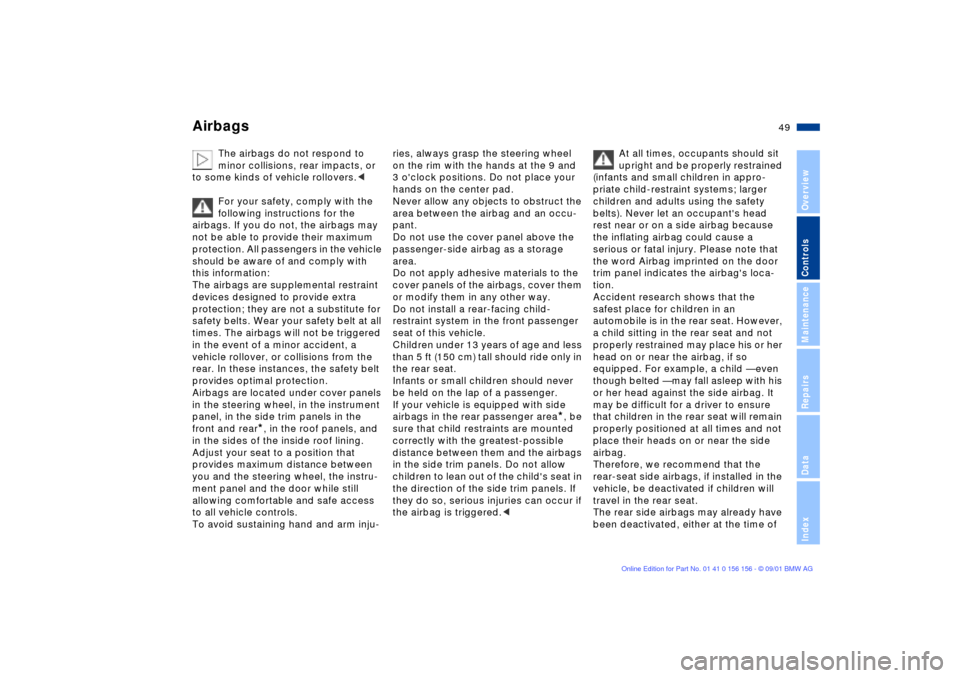
49n
OverviewControlsMaintenanceRepairsDataIndex
Airbags
The airbags do not respond to
minor collisions, rear impacts, or
to some kinds of vehicle rollovers.<
For your safety, comply with the
following instructions for the
airbags. If you do not, the airbags may
not be able to provide their maximum
protection. All passengers in the vehicle
should be aware of and comply with
this information:
The airbags are supplemental restraint
devices designed to provide extra
protection; they are not a substitute for
safety belts. Wear your safety belt at all
times. The airbags will not be triggered
in the event of a minor accident, a
vehicle rollover, or collisions from the
rear. In these instances, the safety belt
provides optimal protection.
Airbags are located under cover panels
in the steering wheel, in the instrument
panel, in the side trim panels in the
front and rear
*, in the roof panels, and
in the sides of the inside roof lining.
Adjust your seat to a position that
provides maximum distance between
you and the steering wheel, the instru-
ment panel and the door while still
allowing comfortable and safe access
to all vehicle controls.
To avoid sustaining hand and arm inju-
ries, always grasp the steering wheel
on the rim with the hands at the 9 and
3 o'clock positions. Do not place your
hands on the center pad.
Never allow any objects to obstruct the
area between the airbag and an occu-
pant.
Do not use the cover panel above the
passenger-side airbag as a storage
area.
Do not apply adhesive materials to the
cover panels of the airbags, cover them
or modify them in any other way.
Do not install a rear-facing child-
restraint system in the front passenger
seat of this vehicle.
Children under 13 years of age and less
than 5 ft (150 cm) tall should ride only in
the rear seat.
Infants or small children should never
be held on the lap of a passenger.
If your vehicle is equipped with side
airbags in the rear passenger area
*, be
sure that child restraints are mounted
correctly with the greatest-possible
distance between them and the airbags
in the side trim panels. Do not allow
children to lean out of the child's seat in
the direction of the side trim panels. If
they do so, serious injuries can occur if
the airbag is triggered.
(infants and small children in appro-
priate child-restraint systems; larger
children and adults using the safety
belts). Never let an occupant's head
rest near or on a side airbag because
the inflating airbag could cause a
serious or fatal injury. Please note that
the word Airbag imprinted on the door
trim panel indicates the airbag's loca-
tion.
Accident research shows that the
safest place for children in an
automobile is in the rear seat. However,
a child sitting in the rear seat and not
properly restrained may place his or her
head on or near the airbag, if so
equipped. For example, a child Ñ even
though belted Ñ may fall asleep with his
or her head against the side airbag. It
may be difficult for a driver to ensure
that children in the rear seat will remain
properly positioned at all times and not
place their heads on or near the side
airbag.
Therefore, we recommend that the
rear-seat side airbags, if installed in the
vehicle, be deactivated if children will
travel in the rear seat.
The rear side airbags may already have
been deactivated, either at the time of
Page 50 of 155
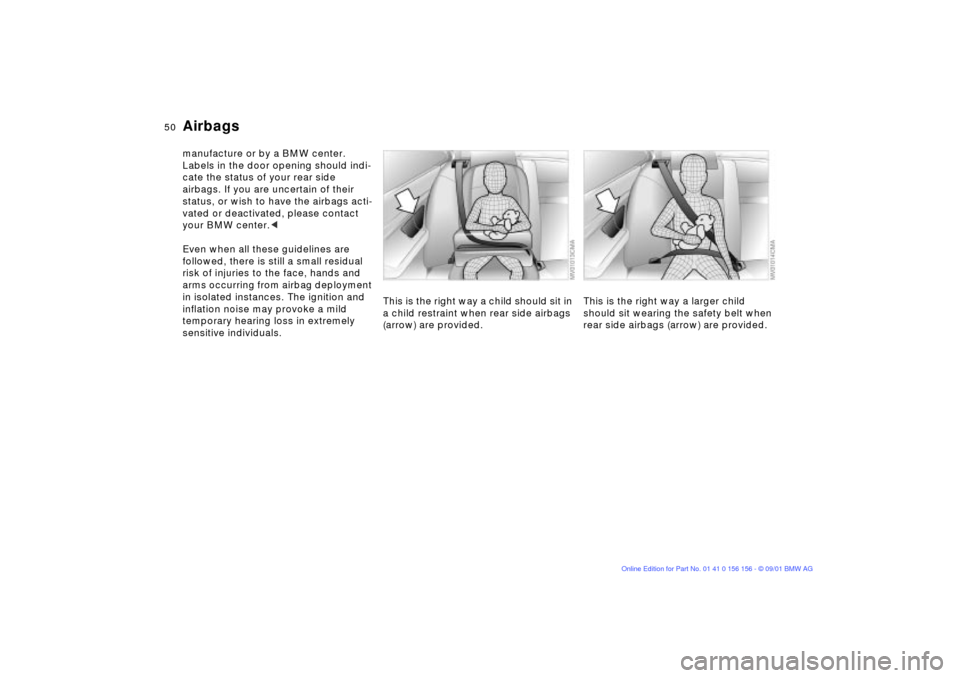
50n
Airbagsmanufacture or by a BMW center.
Labels in the door opening should indi-
cate the status of your rear side
airbags. If you are uncertain of their
status, or wish to have the airbags acti-
vated or deactivated, please contact
your BMW center.<
Even when all these guidelines are
followed, there is still a small residual
risk of injuries to the face, hands and
arms occurring from airbag deployment
in isolated instances. The ignition and
inflation noise may provoke a mild
temporary hearing loss in extremely
sensitive individuals.This is the right way a child should sit in
a child restraint when rear side airbags
(arrow) are provided.
This is the right way a larger child
should sit wearing the safety belt when
rear side airbags (arrow) are provided.